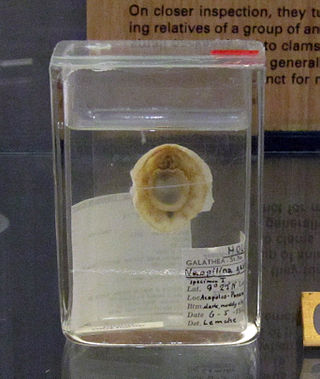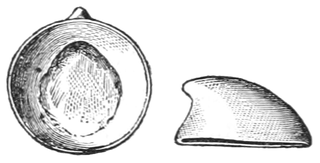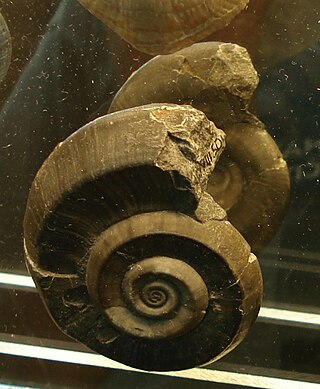
Monoplacophora, meaning "bearing one plate", is a polyphyletic superclass of molluscs with a cap-like shell, inhabiting deep sea environments. Extant representatives were not recognized as such until 1952; previously they were known only from the fossil record, and were thought to have become extinct 375 million years ago.

The Bellerophontida is a taxonomic order of extinct marine mollusks that are found in the fossil record from the Lower Cambrian to the Lower Triassic. They are considered by some experts to be primitive sea snails with primarily symmetrically coiled shells, marine gastropod mollusks.

The Bellerophontidae are an extinct family of specialized globose bellerophontids, Paleozoic and early Triassic mollusks of the class Gastropoda.

Pyramidellidae, common name the pyram family, or pyramid shells, is a voluminous taxonomic family of mostly small and minute ectoparasitic sea snails, marine heterobranch gastropod molluscs. The great majority of species of pyrams are micromolluscs.

Turbonillinae is a subfamily of mostly minute parasitic sea snails, marine gastropod molluscs in the family Pyramidellidae, the pyrams and their allies.

Planorbidae, common name the ramshorn snails or ram's horn snails, is a family of air-breathing freshwater snails, aquatic pulmonate gastropod molluscs. Unlike most molluscs, the blood of ram's horn snails contains iron-based hemoglobin instead of copper-based hemocyanin. As a result, planorbids are able to breathe oxygen more efficiently than other molluscs. The presence of hemoglobin gives the body a reddish colour. This is especially apparent in albino animals.

Bellerophontoidea, common name "bellerophonts", is a superfamily of extinct planospirally-coiled globose molluscs. This superfamily is generally included within the Gastropoda, but may instead be a group of monoplacophorans. The taxon first appeared late in the Cambrian and continued until late in the Triassic.

†Archinacellidae is an extinct family of paleozoic molluscs of uncertain position.
Tropidodiscidae is an extinct family of Paleozoic fossil molluscs with isostrophically coiled shells. They are of uncertain position taxonomically, in other words it is not known whether they were s.
Euphemitidae is an extinct family of Paleozoic fossil molluscs of uncertain position. They have isostrophically coiled shells and may be either Gastropoda sea (snail)s, or Monoplacophora.
Pterothecidae is an extinct family of Paleozoic molluscs of uncertain position, either Gastropoda or Monoplacophora, with isostrophically coiled shells.
Sinuitidae is an extinct family of Paleozoic molluscs of uncertain position. They had isostrophically coiled shells.

Macluritidae is an extinct family of relatively large, Lower Ordovician to Devonian, macluritacean gastropods(?), hypserstrophically coiled, that is dextral while appearing sinistral, of which the genus Maclurites is arch-typical. The base of their shells is flat or gently protruding while the upper side is generally concave.

Lesueurillidae is an extinct family of paleozoic molluscs (gastropods?) with anisostrophically coiled shells of uncertain position (Gastropoda?).
The Anomphalidae is an extinct family of fossil sea snails, marine gastropod mollusks. These are archaeogastropods which are included in the suborder Trochina. The Anomphalidae lived during the Paleozoic, from the Silurian to the Middle Permian. According to some authorities these snails belong instead to the Euomphalacea.
†Onychochilidae is an extinct family of small, fossil, upper Cambrian to lower Devonian molluscs. They have hyperstrophically coiled shells which generally have smooth whorls and elongate apertures. They are commonly considered to be gastropods, i.e. sea snails.

Euomphaloidea, originally Euomphalacea, is an extinct superfamily of marine molluscs that lived from the Early Ordovician to the Late Cretaceous, included in the Gastropoda but speculated as instead perhaps Monoplacophora.

Tryblidiidae is an extinct family of paleozoic monoplacophorans in the superfamily Tryblidioidea.

A selenizone is an anatomical structure that exists in the shells of some families of living sea snails: the slit shells, the little slit shells and the abalone, which are marine gastropod mollusks from ancient lineages.
Phragmolites is an extinct genus of molluscs in the family Bucaniidae, paleozoic molluscs of uncertain position possibly being either Gastropods or Monoplacophorans in the superfamily Bellerophontoidea.











